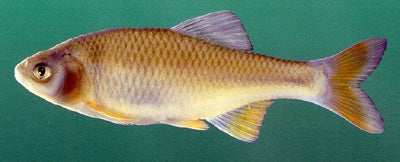RED SHINER
SCIENTIFIC NAME: Cyprinella lutrensis
CHARACTERISTICS: The red shiner is a relatively deep-bodied species with a highly arched back. The head is large and deep, with a pointed snout and large mouth. Breeding males are brightly colored. The back is blue or blue-green, while the back of the head is red, and the opercles are pink or reddish orange. The sides are light blue with a dark, crosshatched pattern. The paired fins are reddish orange with white margins, while the anal fins are red in the center with a white margin. The dorsal fins is typically not expanded. Cyprinella lutrensis typically has nine anal rays and 4-4 pharyngeal teeth. However, this species readily hybridizes with the blacktail shiner, C. venusta, and the hybrids frequently have eight or nine anal rays. Hybrids may also have a faint caudal spot. See Baird and Girard (1853a) for original description.
ADULT SIZE: 1.2 to 3 in (30 to 75 mm)
DISTRIBUTION: The native range of C. lutrensis is the Mississippi River basin and Gulf coastal drainages west of the Mississippi River. Commonly sold as bait, the red shiner has escaped or been released into the Coosa and Chattahoochee river systems, and in some cases it is probably hybridizing with C. venusta. Timmons (1982) includes a record from the upper Tombigbee River drainage, but because we were unable to examine the specimen, we did not include the record in the distribution map.
HABITAT AND BIOLOGY: The red shiner is found in a variety of habitats, from still backwaters to flowing streams. It appears to prefer moderately large creeks with some flow over sand, silt, or gravel, although it also seems to tolerate siltation, turbidity, and other extreme habitat conditions. Spawning reportedly occurs from April to September in the South and Midwest, with individuals living for more than two years (Lewis and Gunning, 1959). The species has been observed spawning in crevices (Gale, 1986) as well as broadcasting gametes in open water and depositing eggs over sunfish beds (Minckley, 1959). The red shiner’s diet includes algae and terrestrial and aquatic insects.
ORIGINAL DESCRIPTION: Baird and Girard described the red shiner in 1853.
ETYMOLOGY:
Cyprinella is a diminutive of Cyprinus, the carp.
Lutrensis means otter, referring to Otter Creek, Arkansas, where this species was first found.
The copyrighted information above is from Fishes of Alabama and the Mobile Basin.






